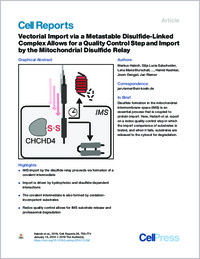Vectorial import via a metastable disulfide-linked complex allows for a quality control step and import by the mitochondrial disulfide relay
- Habich, Markus Institute for Biochemistry, Department of Chemistry, University of Cologne, Germany
- Salscheider, Silja Lucia Institute for Biochemistry, Department of Chemistry, University of Cologne, Germany
- Murschall, Lena Maria Institute for Biochemistry, Department of Chemistry, University of Cologne, Germany
- Hoehne, Michaela Nicole Institute for Biochemistry, Department of Chemistry, University of Cologne, Germany
- Fischer, Manuel Institute for Biochemistry, Department of Chemistry, University of Cologne, Germany
- Schorn, Fabian Institute for Medical Microbiology, Immunology and Hygiene, University of Cologne, Germany
- Petrungaro, Carmelina Institute for Biochemistry, Department of Chemistry, University of Cologne, Germany
- Ali, Muna Institute for Biochemistry, Department of Chemistry, University of Cologne, Germany
- Erdogan, Alican J. Institute for Biochemistry, Department of Chemistry, University of Cologne, Germany
- Abou-Eid, Shadi Department of Biology, University of Fribourg, Switzerland
- Kashkar, Hamid Institute for Medical Microbiology, Immunology and Hygiene, University of Cologne, Germany
- Dengjel, Jörn Department of Biology, University of Fribourg, Switzerland
- Riemer, Jan Institute for Biochemistry, Department of Chemistry, University of Cologne, Germany
-
15.01.2019
Published in:
- Cell Reports. - 2019, vol. 26, no. 3, p. 759-774.e5
English
Disulfide formation in the mitochondrial intermembrane space (IMS) is an essential process. It is catalyzed by the disulfide relay machinery, which couples substrate import and oxidation. The machinery relies on the oxidoreductase and chaperone CHCHD4-Mia40. Here, we report on the driving force for IMS import and on a redox quality control mechanism. We demonstrate that unfolded reduced proteins, upon translocation into the IMS, initiate formation of a metastable disulfide-linked complex with CHCHD4. If this interaction does not result in productive oxidation, then substrates are released to the cytosol and degraded by the proteasome. Based on these data, we propose a redox quality control step at the level of the disulfide-linked intermediate that relies on the vectorial nature of IMS import. Our findings also provide the mechanistic framework to explain failures in import of numerous human disease mutants in CHCHD4 substrates.
- Faculty
- Faculté des sciences et de médecine
- Department
- Département de Biologie
- Language
-
- English
- Classification
- Biological sciences
- License
- License undefined
- Identifiers
-
- RERO DOC 324098
- DOI 10.1016/j.celrep.2018.12.092
- Persistent URL
- https://folia.unifr.ch/unifr/documents/307483
Other files
Statistics
Document views: 98
File downloads:
- den_vim.pdf: 285
- den_vim_sm1.pdf: 142

